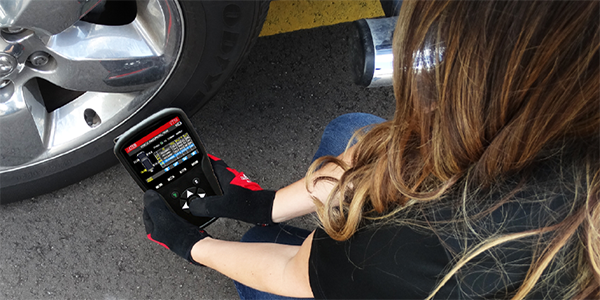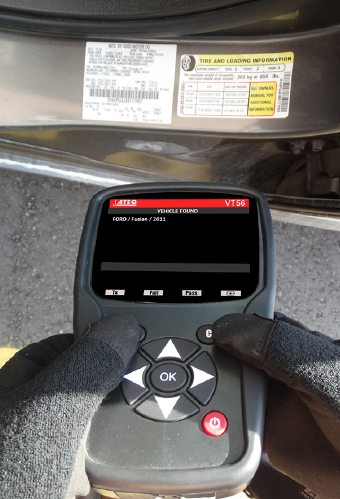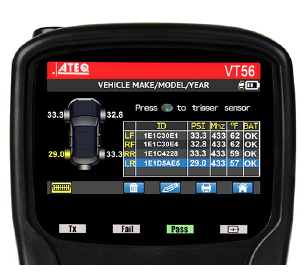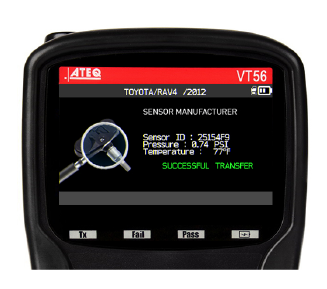How To Find Which Tire Pressure Sensor Is Bad
Service
The Proper Way to Diagnose and Reset TPMS Systems
The tire pressure level monitoring system'due south (TPMS) primary function is to make the commuter aware of the state of tire pressure level inside the tires. Under normal system operations, the TPMS system will alarm the driver when one or more than affected tires PSI reading falls beneath 25% of the vehicle's placard. When the tire sensor indicates "low tire pressure," it sends a radio frequency (RF) signal of 315 or 433 MHz to the ECU on the vehicle that determines if the pressure is below the threshold, which then will indicate a TPMS symbol or position-specific display, depending on the vehicle.

Click Here to Read More
The tire pressure monitoring system's (TPMS) principal function is to make the driver aware of the state of tire pressure within the tires. Under normal system operations, the TPMS arrangement will alert the driver when ane or more affected tires PSI reading falls below 25% of the vehicle's placard. When the tire sensor indicates "low tire pressure level," it sends a radio frequency (RF) signal of 315 or 433 MHz to the ECU on the vehicle that determines if the pressure is beneath the threshold, which and then volition indicate a TPMS symbol or position-specific display, depending on the vehicle.

Direct vs. Indirect TPMS Systems
There are two types of TPMS systems: direct TPMS and indirect TPMS. Direct TPMS systems use TPMS sensors inside the wheel to accurately report pressure level data to the vehicle's ECU in real time. Straight systems include Asian, domestic and European vehicles. An indirect TPMS organization uses an ABS system to monitor the speed of the wheel in order to approximate tire pressure. Indirect systems include Asian and some European vehicles.
What the Dashboard Calorie-free Indicates
The TPMS warning low-cal volition illuminate when a tire is depression, and should eventually exit later a tire has been inflated to its recommended force per unit area according to the vehicle'southward door placard. After starting a vehicle, a TPMS icon will turn on for a few seconds; however, if it stays on, it indicates that one or more of the tires on the vehicle are at least 25% beneath the recommended pressure. If the lite flashes for approximately one to two minutes, it indicates there is a malfunction in the TPMS system.
There are numerous situations that can cause a TPMS warning light to come on or flash. Some TPMS problems include:
• Sensor batteries may be dead;
• Valve itself may have physical damage, corrosion or missing components;
• The TPMS organization voltage supply, wiring or internal electronics may non be functioning properly;
• The tires were serviced or rotated and the relearn procedure was non properly performed.
Information technology is important bank check the TPMS system earlier working on a customer'due south vehicle. Using a TPMS diagnostic tool, select the vehicle's make, model and year manually – or for faster service, scan the vehicle's VIN barcode located on the placard on the vehicle doorjamb to read the sensor information.

Steps to Reset TPMS Systems
The proper steps to reset a TPMS arrangement for vehicles with direct TPMS:
• Use a TPMS diagnostic tool to trigger and read sensor information earlier working on the vehicle.
• Perform the appropriate service to the vehicle's wheels (air pressure adjustment, tire rotation, replace sensors, etc.).
• After the service work has been performed, use a TPMS diagnostic tool to perform the right relearn procedure to reset the TPMS system.
When resetting a TPMS system for a vehicle with indirect TPMS, perform the right initialization process. This may require a TPMS diagnostic tool to notice the steps involved to reset the organization.

Replacing TPMS Sensors
Vehicles with straight-type TPMS systems are equipped with TPMS sensors. If a TPMS sensor is non working, it must be replaced before a relearn procedure can be performed. The damaged TPMS sensor tin can exist replaced with an OE sensor or an aftermarket sensor. There are unlike types of aftermarket TPMS sensors including universal, configurable and programmable sensors. OE sensors, universal and configurable sensors take new sensor IDs already encoded within the sensor and demand to be activated past using a TPMS diagnostic tool. Programmable TPMS sensors require a TPMS diagnostic tool to create new sensor IDs or transfer sensor IDs from the old sensor.
Relearn Procedures
When service has been performed to the vehicle'due south direct TPMS system, such every bit air pressure level adjustment, tire rotation or replacement of sensors, vehicles require a TPMS organisation relearn to be performed. A relearn allows the vehicle's ECU to come across the ID's of each sensor in each wheel. Completing the relearn procedure clears TPMS diagnostic mistake codes and allows the vehicle'due south TPMS system to function properly.
Relearn procedures vary by manufacturer so a technician must know which proper relearn procedure is necessary to put the vehicle in acquire mode. The three types of relearn procedures are: car relearn; stationary, and OBD. Furthermore, some vehicles may use a combination of 2 or more relearn types. Indirect TPMS systems use an initialization procedure, which may require a TPMS tool to figure out the steps involved to reset the system.
According to the AMRA, inside the market of Asian, Domestic and European vehicles equipped with direct TPMS systems, TPMS relearn procedures break out as follows: 38% of vehicles apply motorcar relearn; 27% use OBD, and 35% use stationary.
Machine Relearn Procedure
An auto relearn process is when a vehicle has the ability to larn single or multiple TPMS sensor IDs without the need of performing the relearn procedure with a TPMS tool. Furthermore, a technician can adjust the inflation pressure level, rotate or supervene upon sensors and the TPMS system will reset itself subsequently the vehicle has been driven for a menses of fourth dimension. However, before servicing the tires/wheels, it is always recommended to use a TPMS tool to trigger each of the vehicle's sensors to brand sure they are working properly.
For example, a 2008 Contrivance Charger requires the following automobile relearn process:
• Inflate all tires
• Drive for 20 minutes
Stationary Relearn Procedure
A stationary relearn (sometimes called manual) procedure allows new TPMS sensor IDs to be transferred to the vehicle'southward ECU without driving a vehicle. This type of relearn procedure requires a TPMS activation tool to trigger the sensors when the vehicle is in learn fashion either by using a TPMS diagnostic tool or a diagnostic scan tool. The vehicle then uses a radio frequency (RF) signal to communicate with the vehicle's ECU to constitute which sensor is in which specific location.
For instance, a 2014 Ford Escape with standard ignition requires the following stationary relearn procedure:
• Inflate all tires
• Turn ignition off
• Printing and release brake pedal
• Bicycle ignition from "off" to "run" 3 times ending in "run"
• Press and release brake pedal
• Turn ignition off
• Cycle ignition from "off" to "run" three times ending in "run"
• Horn sounds twice
• Use tool to activate left forepart sensor
• Unmarried horn will sound
Repeat for right front sensor, right rear sensor, left rear sensor
OBDII Relearn Process
An OBDII relearn process requires a TPMS diagnostic tool to transfer new sensor IDs directly to the vehicle's ECU. The user will demand to trigger each TPMS sensor, connect to the vehicle's OBD port, then follow the step-by-step instructions on the tool. The new TPMS sensor IDs are so transferred to the vehicle. Near Asian and specialty European vehicles require OBD relearn.
For instance, a 2011 Toyota Camry requires the following OBDII relearn procedure:
• Inflate all tires
• Read all sensor IDs using TPMS diagnostic tool
• Connect tool to OBDII port
• Reset ECU with tool
• Plow ignition OFF, then ON
• Drive at 12 mph for up to 5 minutes
The Importance of OBD Relearn
Manual and stationary relearn systems can sometimes have several steps to relearn the TPMS organisation. TPMS diagnostic tools have the step-by-stride instructions for auto, stationary and OBD relearn; even so, the steps involved can exist long and complicated. OBD relearn procedures are becoming standard in a shop environment for many reasons. First and foremost, it is the easier to work with since the same procedure tin exist performed no matter the vehicle type. Secondly, OBD relearn saves fourth dimension and confusion for the technician since there are fewer steps to perform.
According to the Automotive Maintenance & Repair Association (AMRA), 62% of vehicles crave a TPMS diagnostic tool and 27% require OBD functionality. Information technology is important to have a reliable TPMS diagnostic tool with first-class OBD coverage to go along upwardly with the growing industry of TPMS. TR
Sheila Stevens is with ATEQ TPMS, LC, a global manufacturer of TPMS diagnostic tools and solutions. For more than data on ATEQ'due south line of TPMS tools and solutions, equally well as additional information on TPMS, visit www.ateq-tpms.com.

Source: https://www.tirereview.com/proper-way-diagnose-reset-tpms-systems/#:~:text=After%20starting%20a%20vehicle%2C%20a,malfunction%20in%20the%20TPMS%20system.
Posted by: wigginscolusay.blogspot.com


0 Response to "How To Find Which Tire Pressure Sensor Is Bad"
Post a Comment